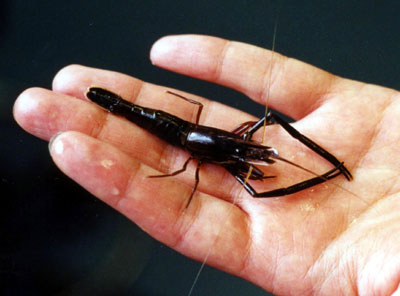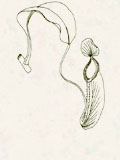
Diversity At A Glance (pdf)
This column aims to introduce interesting species of Hong Kong flora and fauna that might be encountered during fieldwork. Distinctive physical characteristics and some interesting ecological facts are included for each example.
| Editor : | Jacqueline Weir (jesweir@hkusua.hku.hk) |
|
|
|
|
|
Macrobrachium
hainanense
by Sukhmani
Kaur Mantel
 |
| Fig. 1. A large Macrobrachium hainanense. |
Macrobrachium hainanense, known locally as the Hainan Swamp Shrimp (®ü«nªh½¼) is a nocturnal shrimp belonging to the family Palaemonidae that you might encounter in forested upland streams in Hong Kong. These shrimps can be distinguished from other shrimps in these streams by their large chelae, due to which they get their name (Macro = large; brachium = arm). Palaemonid shrimps are present in tropical Asian and Neotropical streams, and species of Macrobrachium are found throughout the tropics, primarily in freshwaters. In Tai Po Kau Forest Stream (TPKFS in Tai Po Kau Nature Reserve) and Tai Shing Stream (TSS in Shing Mun Country Park), the shrimps are generalist predators that feed primarily on slow-moving or sedentary benthic macroinvertebrates. Tagging of shrimps, using individual numbered markers, followed by release in Tai Po Kau Forest Stream pools, was conducted to study their growth rate. Smaller shrimps grew faster than larger ones and growth rate was higher during the summer period. At the age of two years both sexes began breeding and females produced 20-75 eggs per brood between April and August. Males lived longer (up to four years) and grew larger (up to 79 mm total length) than females, which lived for only three years. Since these shrimps are relatively large and predatory in nature, it might be expected that they are important in structuring stream communities (Fig. 1). Experiments were, therefore, conducted in pools of the two streams (TPKFS and TSS) that compared communities of benthic invertebrates in pools with shrimps to pools without Macrobrachium shrimps. Shrimp removal did not result in any significant change in the community, probably since these pools also contain benthic predatory fishes that might have cropped the excess prey made available by removal of the shrimps. Interestingly, however, this shrimp feeds on large quantities of Brotia hainanensis, a snail that is abundant in the streams, with the gut of one shrimp containing 74 small snails! It is therefore believed that the shrimp is probably responsible for the high mortality of small-sized Brotia.
|
|
P.14-15 |
|
Porcupine! |
 Copyright © 2000 |
